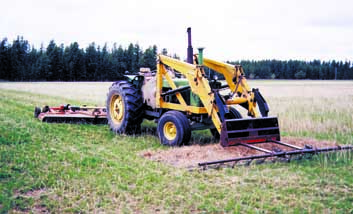Using a harrow to bust up manure patties and a rotary mower to clip weeds at the same time makes pasture maintenance a lot easier and saves time for Dale Pocock, Nipawin, Sask. He hangs a chain harrow from his front-end loader while pulling a 15-ft. wide rotary mower. He says a 50 hp tractor can easily handle the load. "I use a chain harrow made especially for grassland to break up manure clumps and dead plant material," explains Pocock. "Ideally, harrowing should be done in the heat of the day, but even then sometimes you can't get everything. The mower picks up most of what the harrow misses, and the difference in plant height from the mower cut also helps you stay on track." Pocock attached the harrow to the loader using Farmhand quick-attach shafts designed to carry pallets. Then he slips 1-ft. long, 2 1/2-in. dia. pipe sleeves with set screws over the two 4-ft. Farmhand shafts. Adjustable chain hooks fasten the harrow tow bar to the end of the pipe sleeves. They extend out far enough to keep the chain harrow out in front of the tractor with at least a foot of clearance between the harrow and the tractor's front tires, even while turning. Mounting the harrow on the loader provided Pocock with several added benefits. Moving between fields or across roads is simply a matter of lifting the harrow off the ground. It's also easy to clean trash out of the harrow between fields. Pocock also modified his 15-ft. Bush Hog rotary mower. He replaced the constant velocity (CV) joint on the pto with a standard universal joint. Although that means the mower can no longer be engaged while making sharp turns or used on steep inclines, life expectancy and replacement costs were significantly improved. He points out that CV joints have a short life expectancy and cost six to eight times more than standard joints. In addition, the CV joint is significantly heavier for one person to attach. Other adaptations included cutting a slope onto the rear mower shoes. Before making the change, the shoes prevented the mower from being used when backing up. They're now slanted front and rear so the mower can be used around buildings and in other tight areas where backing up is necessary. Pocock has one more modification to make. He plans to hook a rubber tire harrow behind the mower to spread out fresh manure that can't be broken up by the harrow. Keeping his pastures well maintained is important for this experienced grazer and grass seed producer. Pocock cites one pasture that has been in production for 14 years and is as productive as the year it was seeded. He credits harrowing with maintaining productivity and controlling weeds. "I haven't used herbicides on that field since 1986, and there are no weeds to be found," says Pocock. "When you don't spread the manure out, you get dead spots and the cattle eat around it. Then when the manure rots away there is a place for weeds to start up."
1-800-834-9665
Harrow/Mower Combo Keeps Pastures Healthy
FARM SHOW Magazine » Harrow/Mower Combo Keeps Pastures Healthy
Harrow/Mower Combo Keeps Pastures Healthy
